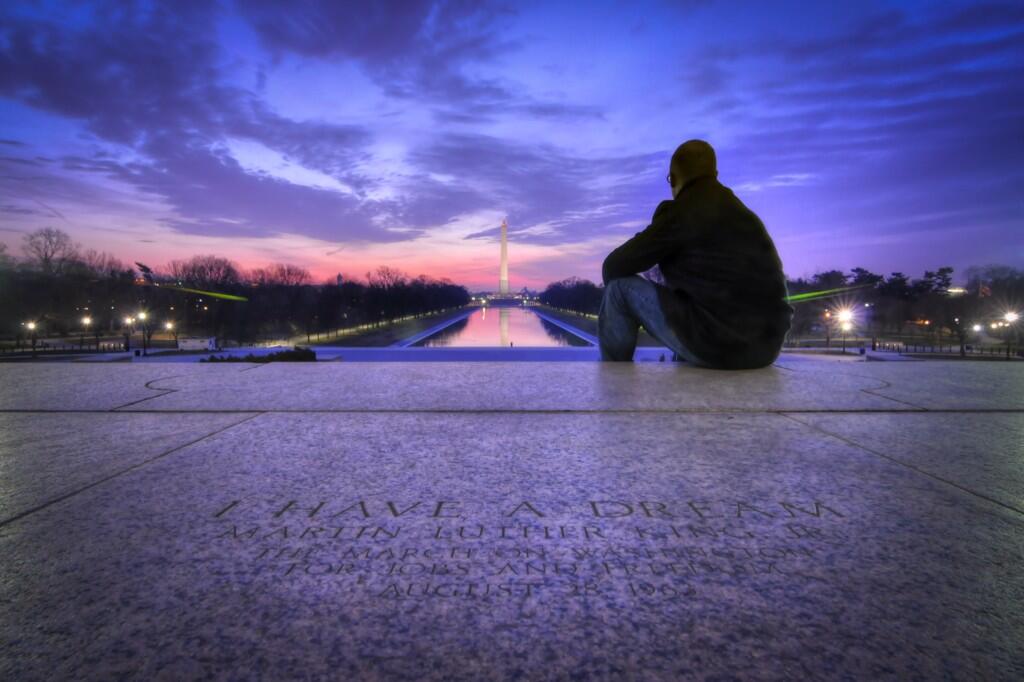U.S. Department of Interior, on Instagram:

Interior’s Instagram caption: It’s not every day you see the #Washington #Monument from this angle. #dc #mall #bestofteday
For me, additional security in Washington, D.C., has stolen much of the fun, joy and awe of the Washington Monument — compounded by the damage from the 2011 Virginia earthquake.
Before September 2011, the Washington Monument was open until midnight in summer months. Tourists head off for dinner and hotels at before 6:00 p.m. — the tourist lines disappear, and especially after 10:00 p.m. on most nights, one could, or one and the three or four visiting friends you had could, without waiting catch the elevator to the top for an absolutely matchless view of Washington D.C. at night.
Spy on the White House; spot the tourists dangling feet in the Reflecting Pool at the Lincoln Memorial; see the light in the Capitol Dome indicating Congress in session, and gloat that you were in recreational mode instead. See a couple kissing on the steps of the Jefferson Memorial, thinking no one would see them. Watch the arc of U.S. Airways airplanes coming down the Potomac River corridor, panicking anyone in the USA Today building who happened to look out and look down on an aircraft passing by, and almost hear the screams from the non-frequent DCA fliers as the plane banked sharply at low level to line up with the runway at National Airport (it will never be Reagan to true aviation buffs, who still miss the controllers who gave us confidence in that thrill ride).
For the Fourth of July, the National Park Service (NPS) used to conduct a lottery to select a tiny handful of professional photographers to shoot the fireworks, one of the best displays on Earth. The fireworks shoot from near the Lincoln Memorial. Does NPS do that any more?
Then walk down the stairway, past the hundreds of carved memorial stones, gifts of Americans who wished to honor George Washington by contributing some large, expensive rock to the interior of the obelisk rising Pharaoh-style out of the swamp near the Tidal Basin. Notice the color line shift that marked the Know-Nothing Party control of the group building the monument — the original American Tea Party austerity group, who stopped construction for 20 years just to prove they could impose austerity on those ‘spendthrifts’ who wished to build a monument to a man, even without any public money, and even though they controlled the commission only from 1855 to 1858 (the Civil War intervened).
The Washington Monument, all 555 feet, 5 1/8 inches of it, is closed now. When I visited last, in June, damage from the earthquake was still being assessed, and to protect the monument and the public, no access to the interior was allowed. Around the base, the 50 U.S. flags still fly 24 hours each day; but the paths to the monument now have blockades to stop any unauthorized truck, perhaps laden with explosives, and the public benches sat empty where we used to meet small-town Americans awed by the thing, and foreign tourists in awe of America.
The caption from Interior begs more explanation. Why don’t we see this view? The Washington Mall — that expanse of grass and, now, museums between the U.S. Capitol on the east end and the Potomac-side Lincoln Memorial on the west — graces pilots’ air charts as a civilian no-fly zone. After too many small-plane pilots gave the FAA fits, and somebody parked one on the lawn of the White House, FAA banned all flights over the mall, except by police or other official aircraft. Pragmatically it’s the D.C. cops and Marine One helicopters who might be able to capture this view.
How did Interior get the shot? The Instagram doesn’t explain. Perhaps it was part of the work to repair and restore the monument from the earthquake.
This picture highlights some interesting things. You can see wear and discoloration of the stone, from weather. Discoloration is not consistent; you can see how the windows at the top alter the even flow of water. Acid rain causes the stone to turn gray, then black; the monument is light only from a couple of scrubbings (though, contrary to climate denialist and GOP claims, Clean Air Act control of acid rain reduces the damage since 1972). Some of the discoloration may be from copper solutions washed off the window frames by the rain.
If you look closely, you can see one of the cracks caused by the earthquake. At the peak rests a tiny pyramid of aluminum, undistinguishable from the limestone. Aluminum? Yes — while the metal is a very common element around the Earth, refining it out of ore was difficult, commercially impossible in the 1880s when the Monument was completed. As a last tribute to Washington, builders capped it with what was then one of the most precious metals on Earth, aluminum. Soon after, the advent of mass quantities of generated electricity made aluminum refining commercially viable; today we make disposable drink cans out of what was once the most precious metal on Earth, when purified. One may ponder how George Washington would consider such technological changes in the nation where he hoped every citizen might have a “vine and fig tree,” first to cap his monument with aluminum, and then make millions of tons of the stuff to throw away. We are an industrial society to an extent Washington did not, perhaps could not anticipate. Would he approve?
About a quarter of the way up from the base, you see the color of the limestone changed, as I noted earlier. All the stone on the face of the monument came from the same quarry; however, during the cessation of construction during the rule of the Know Nothings on the monument commission, rock from the quarry continued to come out, to be used in other projects. By the time construction on the monument was restarted, rock quarrying pulled out limestone of a slightly darker, more reddish color. Builders decided to continue with the color variation rather than pull down the stone already stacked. The Washington monument thus becomes a memorial not only to Washington, but also to the politics he futilely hoped would not affect our nation’s government, even non-governmental commissions working around and about the government. That color line preserves in stone some of the political errors of the mid-19th century. It remains unclear whether anyone ever learned a beneficial lesson from those times.
At the base you see patterns of stone unrecognized at ground level (are those white stripes the benches to wait in line to get up to the top?). Around the monument a phalanx of 50 U.S. flags, which fly constantly (except in hurricanes), and you can see the lights that illuminate the flags and the monument at night. Flying into Washington, D.C., at night, becomes one of the great vistas of the world, pierced by the shining white spire of the Washington Monument against a black sky (or dark blue, better), and the panorama of great public buildings, also lighted limestone.
Under local and federal zoning rules, skyscrapers are not allowed in that core area, to preserve the buena vista.
And finally, in the photo you can see fewer than a dozen people, colored dots at the base of the structure. Are they looking up?
More:
Spread the word; friends don't allow friends to repeat history.





 Posted by Ed Darrell
Posted by Ed Darrell 


























